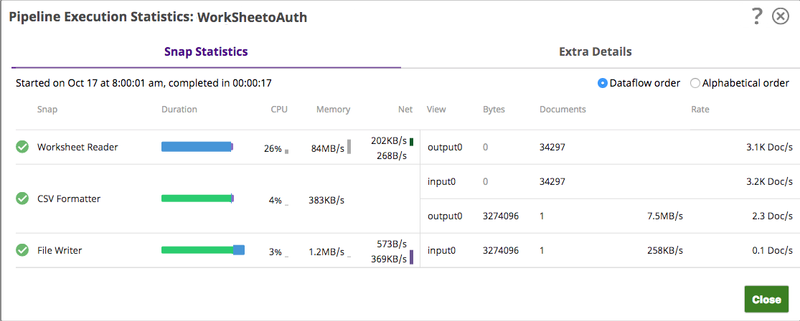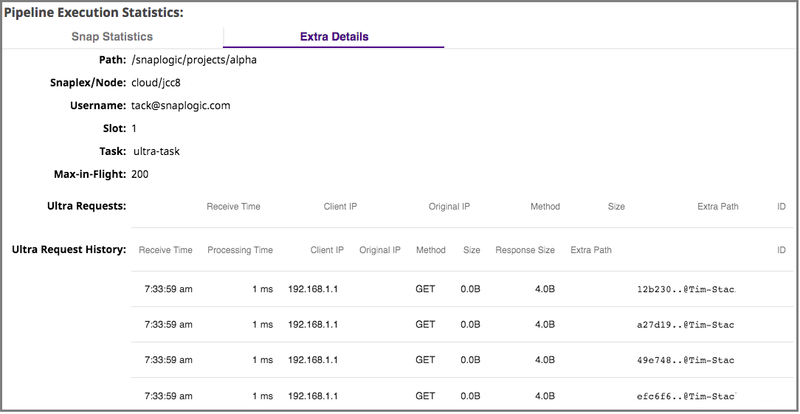In this Article
| Table of Contents | ||
|---|---|---|
|
Overview
The Pipeline pipeline Execution Statistics popup pop-up provides information on the Pipeline status pipeline status when executed. Likewise, when validating a Pipelinepipeline, you can display view Pipeline Validation Statistics.
...
- In Designer, click to open statistics for the current execution or validation of a Pipelinepipeline.
- In the Dashboard > Pipeline, click on the status (Completed for past statistics and Started for active statistics) in the Status column.
As a Pipeline pipeline executes, the statistics are updated periodically so that you can monitor its progress. If the execution is successful, the Snaps should transition from Started to Completed, as shown in the following image.
| Snap Statistics tab | Extra Details tab |
|---|---|
The Snap Statistics tab summarizes pipeline execution time, including fractional components representing seconds. The Extra Details tab gives a precise timestamp of pipeline start and completion times, aiding in understanding execution duration.
You might notice a difference between the pipeline execution time displayed in the Snap Statistics tab and the Extra Details tab on the pipeline dashboard. For example, the Snap Statistics tab displays pipeline execution completion time as 2.30 minutes, and the Extra Details tab shows completion time from Jan 25 at 1:37:54 am till Jan 25 at 1:40:12 am.
The time displayed in the Snap Statistics tab does not represent minutes and seconds in the traditional sense. Instead, it includes a fractional component representing a portion of a second. For instance, in this example, the 0.30 fraction of the time translates to 30/100*60 = 18 seconds. The actual execution time for the pipeline would be 2 minutes and 18 seconds. This aligns with the completion time indicated in the extra details tab.
Snap Statistics
This tab displays the overall statistics for each Snap on the left and the statistics for the Snap's input, output, and error views on the right. You can change the order of the Snaps in the table by selecting Dataflow or Alphabetical on the top right. The Alphabetical listing orders statistics by the Snap name, while Dataflow orders statistics by placing adjacent Snaps together in the table (though if two or more Snaps are at the same depth in a Pipelinepipeline, they are shown in random order because of the algorithms used to sort them).
| Note |
|---|
Selecting Dataflow displays the order of data flow in the current instance of the Pipelinepipeline, which may differ from the data flow at the time when the Pipeline pipeline was executed. |
| Note |
|---|
Owners of child Pipelines pipelines can access runtime logs and Snap statistics of the parent Pipelines pipelines if one or more of the following is true:
|
Failures
If the Pipeline pipeline fails, you see inline which Snap failed.
...
Warnings might display for Snaps if a potential problem is detected that should be addressed. For example, Pipelines pipelines that use a deprecated version of the Join Snap display a warning, as shown in the following image:
Pipeline pipeline executions with warnings show up in the Dashboard with a warning icon next to their execution status for easy identification:
- Pipeline pipeline completed with errors—indicates that a Pipeline pipeline with error pipeline that processed at least one document.
The error Pipeline pipeline displays a Completed status. When you hover over the status of the main Pipelinepipeline, Pipeline pipeline has snaps that processed error documents is displayed. - Pipeline pipeline completed with warnings—indicates that warnings occurred for Snaps in the Pipelinepipeline.
The current set of warnings are as follows:- Deprecated Snap: Snaps that are no longer supported should be replaced with newer versions of the Snap to avoid any potential issues.
- Passing a string to the toLocaleDateTimeString(), toLocaleDateString(), and toLocaleTimeString() methods: Early versions of these methods would only accept a JSON-encoded string for the format argument. More recent versions accept an object literal, which is significantly faster and compliant with the ECMAScript standard.
- Passing a JSON-Path to the hasOwnProperty() method: The hasOwnProperty() incorrectly treated its argument as a JSON-Path instead of a plain property name.
Pipeline Status States upon Completion
When you execute a Pipeline pipeline on the Designer canvas, you can view the states of execution.
...
The Duration bar charts provide an overview of how long the Pipeline pipeline takes during the processing of each document. The width of the chart represents the overall run time of the Snap and is broken down into three sections with different colors:
Input wait time as green.
Execution time as blue.
Output wait time as purple.
The input time and output time are how long the Snap takes waiting for its neighbor Snaps to do their processing. The execution time is how long the Snap takes to process documents. You can mouse over the Duration bar to see the exact amount of time that the Snap takes waiting or executing.
- When optimizing a Pipelinepipeline, you can use the duration bar chart to identify the bottlenecks by looking for Snaps with a large blue bar.
- Ultra Pipelines pipelines have an additional Idle metric that indicates how long the Pipeline pipeline has been idle and not processing any documents. The idle time is subtracted from the input wait time to indicate where bottlenecks are located in an Ultra Pipelinepipeline.
- The CPU %, Memory, and Net columns display the average resource usage for that Snap.
- The CPU usage indicates how much CPU time the Snap itself consumed while working.
- The Memory column indicates how much memory is being allocated by the Snap.
- The Net column shows how much data the Snap received or transmitted over the network.
If you are seeing high resource usage on your Snaplex node, you can use these metrics to help identify the potential causes. Hovering over these columns will open a dropdown list that shows additional detail.
Each Snap has Views that accept or produce documents to be processed. Each view has its own statistics display for the number of documents processed and the rate at which the documents flow through the view.
The Bytes column populated for Snaps that have binary views and displays the total amount of data that has passed through the view.
The Documents column shows how many structured or binary documents flowed through the view.
Note title Binary Views Binary views can send multiple documents, for example, a ZipFile Reader Snap will output a separate binary document for each file in the Zip.
The Rate column is a rough approximation of how quickly the documents flow through the view. If the Snap has binary views, the byte rate is also displayed.
When you mouse over the resource columns in a row, the row highlights and a dropdown will appear to show even more information. The top half of the dropdown has sections which display the average usage of a resource for every document that is processed, a chart showing the last minute of activity, and the total usage of the resource over the full run-time of the Snap. The bottom line shows the version and build information for the Snap class.
...
While this tab appears for all Pipelinespipelines, it only displays information for those Pipelines pipelines that are run either by a task or by another Snap (such as the Pipeline pipeline Execute Snap). Values are returned only for those parameters that have Capture selected in the Pipeline pipeline Properties dialog.
Extra Details
The Extra Details tabs provides basic information about the Pipeline pipeline and its execution, including details about Pipeline pipeline type and run policy.
In the following image, the Extra Details tab displays information about an Ultra Pipeline pipeline Task.
In the following image, the Extra Details tab displays information about a Resumable Pipelinepipeline.
The Extra Details tab provides additional information about the Pipeline pipeline run, including:
- Path to the pipeline.
- The Snaplex node used to run the Pipelinepipeline.
- The username of the person who ran the Pipelinepipeline.
- The Slot Count. See Maximum Slots on the Node Properties tab on the Update Snaplex dialog.
- Resumable Mode. Displays Enabled if the Pipeline pipeline is resumable. If not, the status is Disabled.
- The Task name. The name of the Task (if applicable).
- The Max-In-Flight value. The maximum number of documents that can be processed by an Ultra task instance at any one time.
- The Close reason for when an Ultra task goes into the Completed state.
- Reference no longer exists or is inaccessible
- Host Snaplex node restarted
- The Ultra task has been updated
- The task is no longer active
- Closing Ultra Pipeline pipeline instance to balance instances across the Snaplex
- Ultra Requests. These statistics are displayed during the processing of documents.
- Receive Time. The time that the request is received.
- Client IP. The IP address that the FeedMaster sees when the load balancer forwards a request.
- Original IP. The IP address of the external client that the load balancer, when configured to do so, forwards to the FeedMaster.
- Method. The underlying HTTP method of the request.
- Size. The size of the document payload in bytes.
- Extra Path. The path of the Ultra Pipeline pipeline task.
The Request History for Ultra tasks. These statistics display the last 100 documents processed in the Ultra Pipelinepipeline.
Info title Pipeline Monitoring API Available You can also collect the Ultra history statistics using the Pipeline pipeline Monitoring API.
Some statistics in common with those from the Ultra Request report are identical.Receive Time. The time that the request is received.
Processing Time. The total time for the Ultra Pipeline pipeline to process the documents associated with this request. For example, if the input document is copied, this time includes all the time needed to process each copy.
- Client IP. The IP address that the FeedMaster sees when the load balancer forwards a request.
- Original IP. The IP address of the external client that the load balancer, when configured to do so, forwards to the FeedMaster.
- Method. The underlying HTTP method of the request.
- Size. The size of the document payload in bytes.
- Response Size. The size of the document in bytes payload inside the response.
Extra Path. The path of the Ultra Pipeline pipeline task.
State Transition. These statistics display when multiple runs of an Ultra Pipeline pipeline occur.
State. Current state of the Ultra Pipelinepipeline.
Timestamp. The time that the most recent Ultra Pipeline pipeline execution occurred.
Username. The username of the person invoking the Ultra Pipelinepipeline.












